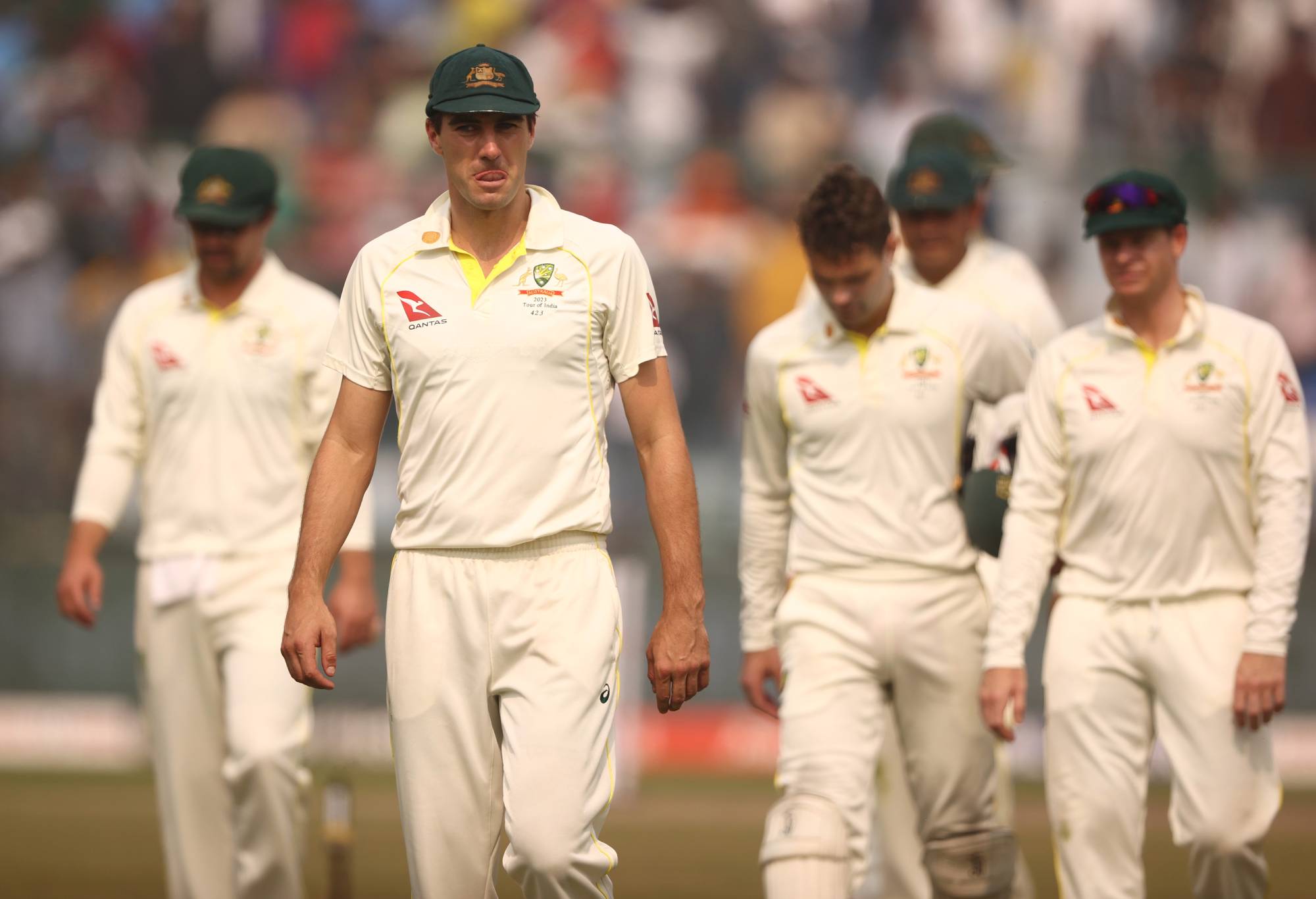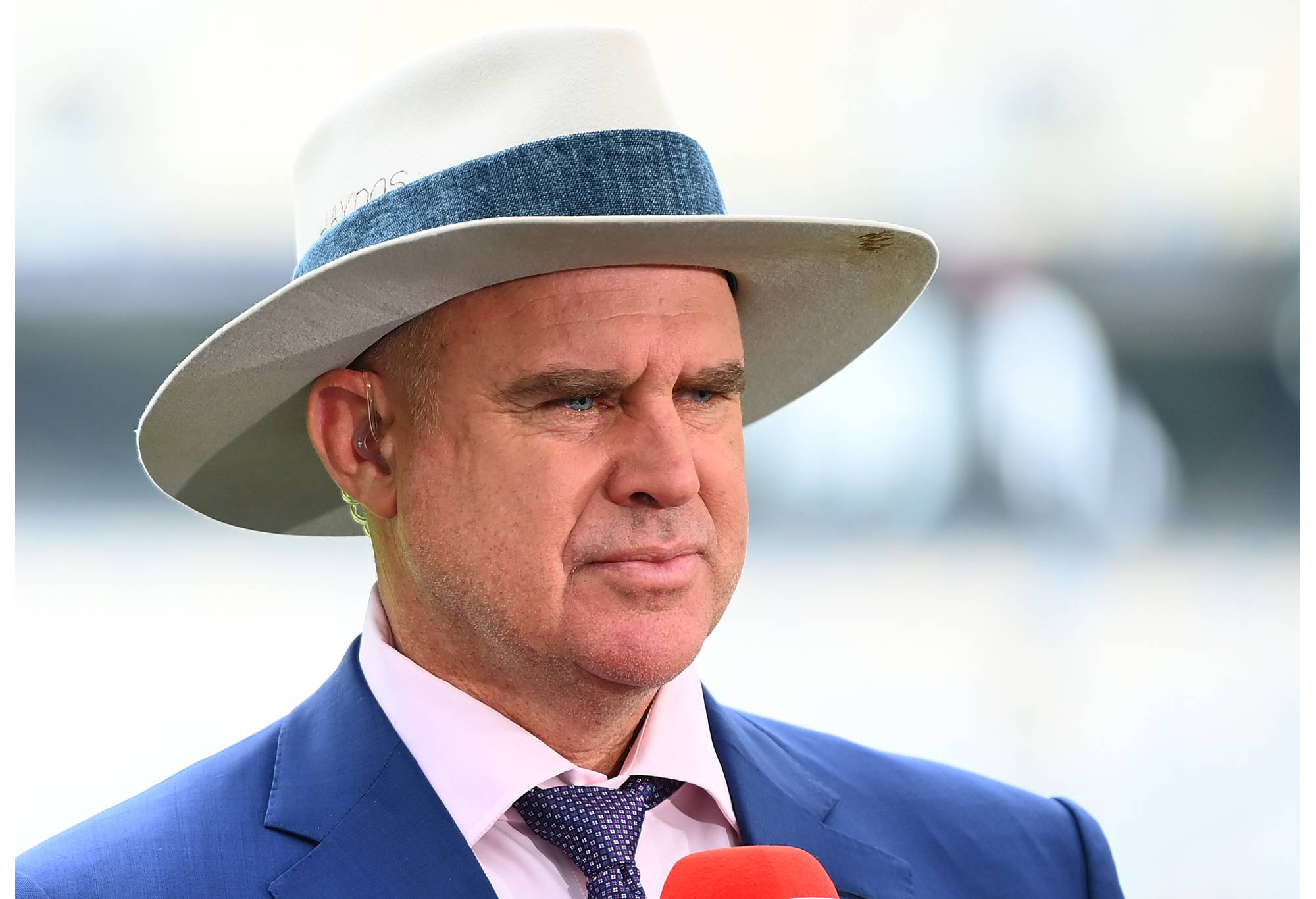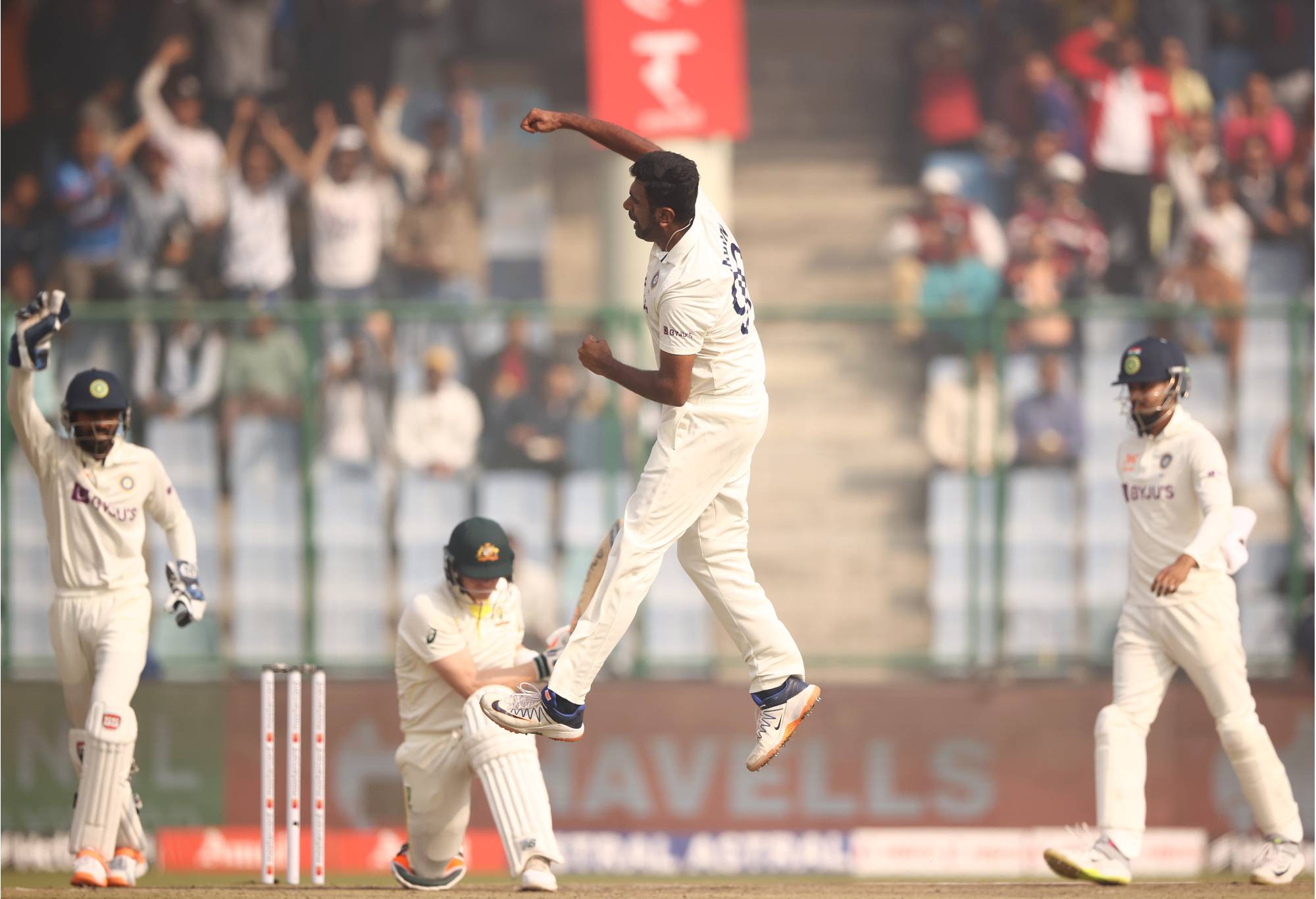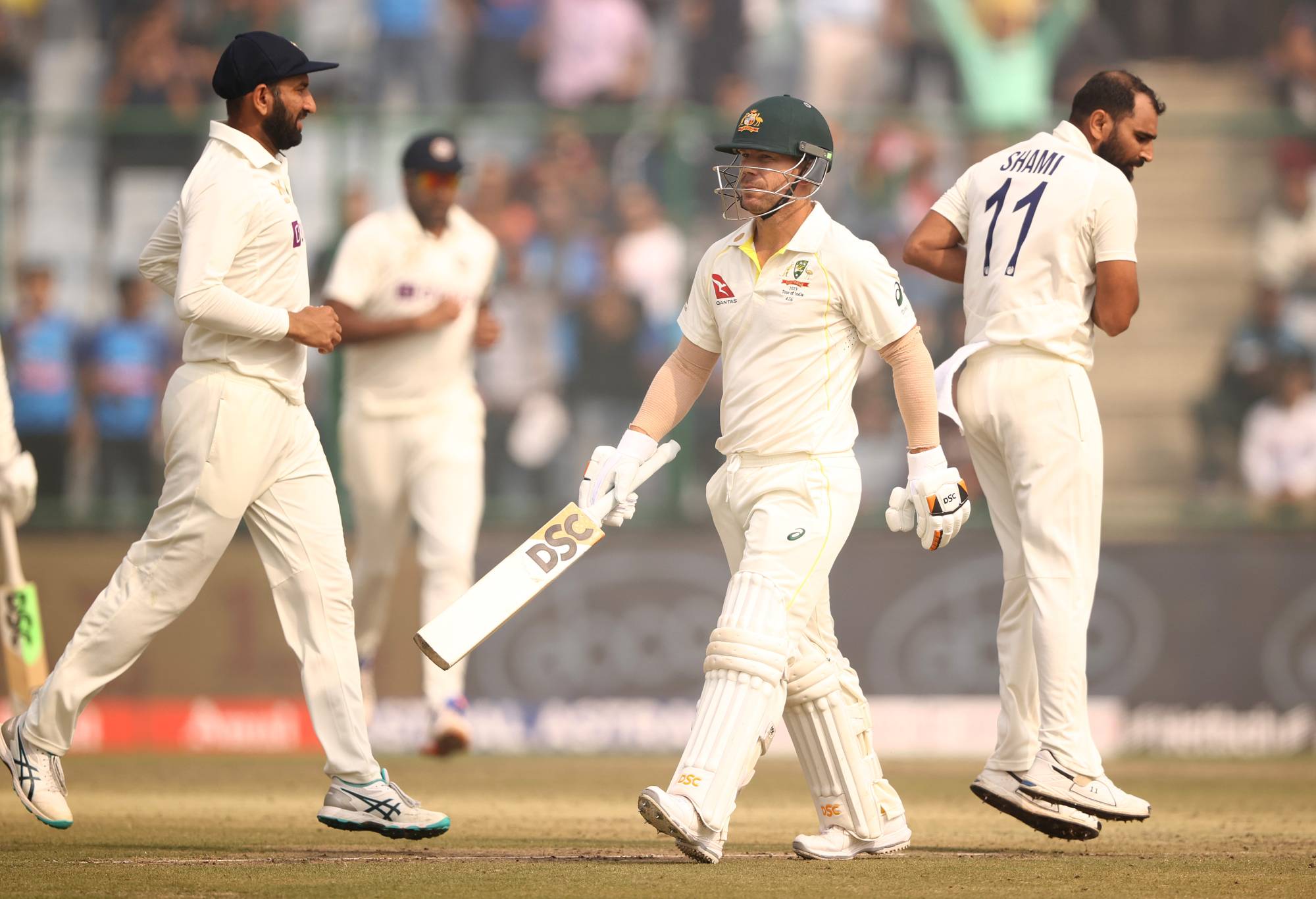Australia are in disarray after their Delhi drubbing and they now face the very real prospect of again being knocked out of the World Test Championship final.
They have nearly more than a week to regroup before the next Border-Gavaskar Trophy match at Indore (it was only supposed to be a seven-day break but three-day Tests have been the norm this series).
After missing out on the original World Test Championship final by the barest of margins due to a poor over rate, they are now in danger of missing June’s decider in England despite sitting pretty at the top of the standings for the majority of the past two years.
If they lose the next two Tests, they could again miss the boat if Sri Lanka win both matches in New Zealand next month.
CLICK HERE for a seven-day free trial to watch cricket on KAYO
Despite upsetting India in the first final, the Black Caps have been struggling of late and have won just two, lost seven and drawn three matches since lifting the inaugural trophy.

Pat Cummins leads his team off the ground after they were defeated by India on day three of the Second Test at Delhi. (Photo by Robert Cianflone/Getty Images)
The Kiwis are too nice to do it deliberately but they’d allow themselves a wry smile if they were to lose 2-0 and it inflicted pain on their trans-Tasman nemesis.
Australia can seal their place in the decider by drawing or actually winning either of the next two Tests in India.
Considering both of the first two Tests were over before the tea break on day three, playing for a draw looks out of the equation even if they wanted to give it a try.
To have any chance of avoiding a whitewash, they need to sort out these key problem areas.
Tactics
The sweep science: When in Rome do as the Romans do so when in India, bat like their masters of the turning ball. (Although with the next match being in Indore that doesn’t mean you should play indoor cricket – that works better when you say it aloud rather than as the written word.)
India’s batters don’t sweep at every opportunity so why have the Australians decided that’s the tactic that will work for them.

Matthew Hayden. (Photo by Quinn Rooney – CA/Cricket Australia via Getty Images)
Matthew Hayden used the sweep to great effect in 2001 as he bludgeoned 549 runs at 109.8 with 119 in the first Test, a 97 in the second and a magnificent 203 in the series finale. He was apparently seen with a broom on the Delhi pitch mocking the current team while filming an upcoming segment for host broadcaster Star Sports – that will be interesting viewing, to say the least.
But just because the sweep tactic worked for the tall Queensland opener after he spent months preparing specifically for it, doesn’t mean it will work for every Australian batter.
India’s batters mainly come forward to spin but whether they’re moving onto the front or back foot, they are decisive. Their hands follow their feet. With the Australians there does not appear to be the same synchronicity of limbs.
Peter Handscomb, Marnus Labuschagne, Usman Khawaja and Steve Smith have fleetingly looked comfortable with their footwork to the spinners but have too often brought themselves undone with injudicious shots.
“There were some people who went clearly away from the game plan that made them successful over a period of time and that’s for us to own as a collective,” coach Andrew McDonald said in his Monday press conference.
“We’ve got to be better than that, that’s the bottom line, we’ve got to own it and we are not here to shy away from the fact that wasn’t good enough.”
Bowl at the stumps: They would have and definitely should have been taught this in the under 10s. It sounds simplistic but it applies in India more than anywhere else.
LBW and bowled dismissals for India this series: Australian batters were out 13 times in Nagpur and 12 in Delhi to these two dismissals. India: Six in the series opener and six in the second Test.
Again, there’s much more to getting wickets in India than aiming at the pegs but the natural variation which can manifest itself in the kind of skidding delivery which claimed Rohit Sharma in Delhi is only useful if it’s on target.
With Pat Cummins calling correctly both times, Australia have had the luxury of bowling second in each Test but they have failed to take advantage either time – they didn’t even get to bowl last in the first match.

Ravichandran Ashwin celebrates taking the wicket of Steve Smith. (Photo by Robert Cianflone/Getty Images)
Selections
No Warner, no matter what: With scans revealing a small fracture on his elbow on top of the failed concussion test which ruled him out mid-match in Delhi, the veteran opener is unlikely to be available for the third match.
That aside, his poor returns of 1, 10 and 15 in his first three trips to the crease, following on from subpar tours to India in 2013 and ‘17 add up to someone who cannot be trusted to produce in these conditions.
Matt Renshaw is the only other specialist opener in the squad but his only four runs from three innings have been from three edged deliveries and a single to mid-on so Travis Head, after his encouraging 43 at nearly a run a ball in the second innings in Delhi, should walk out to bat with Usman Khawaja to start the Australian innings at Indore.
“He’s (Warner) still sore at the moment. If Dave’s unavailable it would make perfect sense,” McDonald said on Head remaining at opener. “We’re in no rush to make any decisions at this point in time around Davey.
“It will be basically how sore and how functional it (the elbow) is as to what decision we make with him and then the length of the injury. There’s some talk the length of injury could be anywhere between a week-plus depending how that settles down.”
Green a no-brainer but is Starc?
All-rounder Cameron Green and Mitchell Starc were both considered touch and go for Delhi so they should be fully recovered from their respective finger injuries next Wednesday.
Green replaces Renshaw in the middle order while if Starc is brought back in, Matt Kuhnemann would get the chop after taking two wickets and not getting smashed on debut but lacking penetration with his left-arm spinners.
Cummins didn’t even bother bowling himself in the second innings at Delhi, using Head’s part-time offies as the fourth option after the three frontline spinners.
If Green joins Cummins at Indore, do the Australians also need Starc’s left-arm pace as well?

David Warner walks off after he was dismissed by Mohammed Shami. (Photo by Robert Cianflone/Getty Images)
Nathan Lyon and Todd Murphy nearly racked up 50 overs each in Nagpur and they should have Head as a third tweaker for game three so leaving Starc out opens the door for another batter.
Green could then come in at No.7, Alex Carey at eight followed by Cummins, Lyon and Murphy but it would also mean a recall for Renshaw or Warner as there are no other options in the squad.
Glenn Maxwell made his return from his broken leg in club cricket last weekend but it’s highly unlikely they’d be flying him over Kuhnemann style with very little cricket under his belt, let alone of the long-form variety.
If Warner is available, it looks like the selectors will have a choice of going with a sixth specialist batter and giving him or Renshaw another chance despite wretched form or selecting Starc and zagging with a pace-heavy attack while India zigs with spin.
Having options is over-rated: The truly great teams have a set XI and only change it in the case of injuries or retirements.
The Australians are yet to announce whether Mitchell Swepson will return to the tour after returning home for the birth of his first child while it appears Ashton Agar is fulfilling a role of glorified net bowler/specialist substitute fielder.
If the selectors were that put off by Agar’s average display in the SCG Test last month, they should have bitten the bullet and not picked him altogether.
Another left-armer, NSW seamer Mike Whitney took 7-89 against the mighty West Indies in 1989 at Adelaide in the last match before the Ashes touring party was announced.
The selectors didn’t think he had the bowling style that would work in England so they recalled Terry Alderman and Geoff Lawson instead.
It was a bitter pill to swallow for Whitney but in hindsight it was the right call as Alderman (41 wickets) and Lawson (29) cut a swathe through the English batters.
The fact that the current brains trust flew Kuhnemann in to make his debut ahead of Agar proves that they made a blunder from the get-go.
An astute reader of The Roar made a comment the other day that variety wasn’t necessary for those Windies line-ups that Whitney had his day out against.
When they played in the subcontinent during their heyday in the 1980s they’d bring off-spinner Roger Harper into the attack instead of one of their four fearsome quicks and Viv Richards or Carl Hooper would step up with some off-spinners.
They were that great that they didn’t lose a series anywhere, whether the wickets were turning in India, bouncing in Australia or seaming in England from 1980-95.
Steve Waugh’s side was on a similar path in the 1990s with a world record hot streak of 16 Test wins in a row. If it was spinning, they’d bring in Stuart MacGill or Colin Miller to join Shane Warne, Glenn McGrath and Jason Gillespie, otherwise complete their attack with Brett Lee, Damien Fleming or Andy Bichel.
Not a bad line-up. They didn’t need to tinker with the batting too much either.
It was all going swimmingly until 2001 … when they arrived in India.
































































































